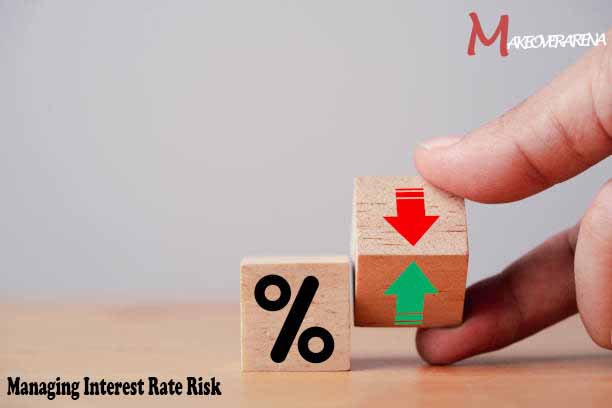Interest rate risk is a major concern for everyone, including consumers, companies, and financial institutions. It refers to the potential damage that interest rate changes could do to the value of assets or liabilities.

A wide range of economic, financial, and geopolitical events can cause interest rates to rise or fall, so it is crucial for stakeholders to build thorough plans to properly manage this risk. In this article, we will explore Managing Interest Rate Risk, the nature of interest rate risk, its implications, and various strategies for it.
What is the Interest Risk Rate?
Interest rate risk refers to the risk of potential investment losses that can be initiated by an upward shift in the prevailing rates for new debt instruments. In the event of an increase in interest rates, such as when they rise, the secondary market value of a bond or any other fixed-income investment is likely to experience a decline. This change in a bond’s price in response to fluctuations in interest rates is commonly referred to as its duration.
Types of Interest Risk Rate
Interest rates have a built-in tendency to fluctuate, which has an impact on how much financial assets and liabilities are priced. There are two basic categories of this risk:
Price Risk (Market Risk)
The value of fixed-income assets, such as bonds, can change as a result of shifting interest rates. When interest rates rise, the market value of existing bonds falls because new bonds with higher coupon rates become more attractive. On the other hand, existing bonds’ market value increases as interest rates fall.
Reinvestment Risk
This refers to the possibility that future cash flows from fixed-income securities will be reinvested at interest rates that are lower than those of the initial investment. Investors may see fewer returns when their investments mature and need to be reinvested in a situation when interest rates are declining.
Factors Affecting a Company’s Interest Rate Risks
Let’s take a look at some factors affecting a company’s interest rate risks;
Regulatory Environment
Regulation changes may affect a company’s exposure to interest rate risk. Finance alternatives and interest rate risk management procedures may be impacted by changes in banking legislation, accounting standards, or governmental policies.
Risk Control Strategies
Through a variety of tactics, including interest rate hedging via derivatives like interest rate swaps or options, businesses can actively manage interest rate risk. The success of these tactics hinges on a company’s willingness to take on risk and its capacity for making precise interest rate predictions.
Economic Situation
Interest rate risk is significantly influenced by the overall economic climate. The direction and size of interest rate fluctuations can be influenced by macroeconomic variables like inflation expectations, monetary policy, and economic growth rates. These economic indicators must be closely watched by businesses to spot any prospective rate changes.
Creditworthiness
Stronger credit ratings make it easier for businesses to access lower-cost financing options, while those with weaker credit profiles frequently struggle with higher borrowing costs, thereby increasing their exposure to interest rate risk. Creditworthiness is crucial to a company’s ability to secure favorable interest rates.
How to Manage Interest Rate Risk
Understanding how to handle interest rate risk is essential because it can seriously harm a business and even lead to bankruptcy. We’ll explore some ways to manage interest rates and the related risks in the following sections.
Diversification
Diversification is a fundamental strategy for managing interest rate risk. By spreading investments across a variety of asset classes such as fixed-income securities, equities, real estate, and alternative investments within a portfolio, companies can create a diversified investment mix that not only offers protection against adverse rate movements but also enhances the potential for achieving favorable returns and minimizing the overall impact of interest rate fluctuations on their financial performance.
Cash Flow Management
In order to protect against prospective interest rate swings, cash flow management is an essential part of interest rate risk management. Businesses and individuals can position themselves to take advantage of possibilities brought on by rising interest rates or to make profitable refinancing decisions in a decreasing interest rate environment by carefully maintaining enough liquidity and cash reserves. This tactical method guarantees both financial stability and the possibility of tactical financial advantages under a range of interest rate situations.
Swap
For borrowers who prefer flexibility in a floating-rate environment, an alternative financial instrument worth exploring is the interest rate swap. This financial product empowers the borrower to secure their floating rates for a specified period, typically ranging from one to five years, either through their own bank or another institution, provided they meet credit requirements.
It’s important to note that while there’s typically no upfront fee associated with interest rate swaps if market rates drop below the agreed-upon fixed swap rate, the borrower will be obligated to compensate the counterparty for the difference, making it essential to carefully monitor the market conditions and evaluate the potential risks associated with this hedging strategy.
Asset-Liability Management
Financial institutions frequently use asset-liability management (ALM) as a strategic strategy to align the durations and interest rate characteristics of their assets and obligations. The coordination of cash flows plays a crucial role in reducing the effects of interest rate changes and strengthening the resistance of their net interest margin to market volatility. Financial institutions may efficiently optimize their resource management and risk management procedures using ALM, ensuring their financial stability in a constantly changing economic environment.
Floating-Rate Securities
Investing in floating-rate securities, such as floating-rate bonds or adjustable-rate mortgages, can provide protection in a rising interest-rate environment. Because their interest payments adjust with market rates.
Conclusion
Interest rate risk is a pervasive and complex challenge that affects businesses, and financial institutions. It can have far-reaching implications on investment returns, borrowing costs, and overall financial stability. However, with a well-structured risk management strategy stakeholders can navigate the volatile interest rate environment more effectively.
CHECK THESE OUT:



